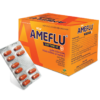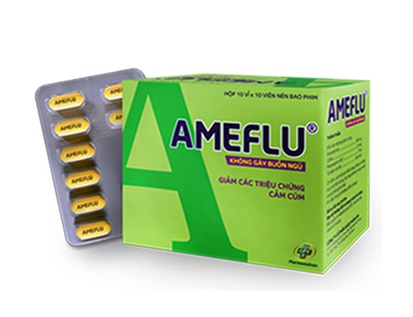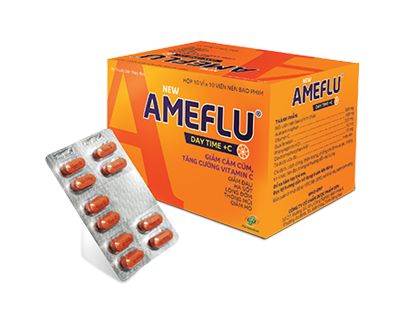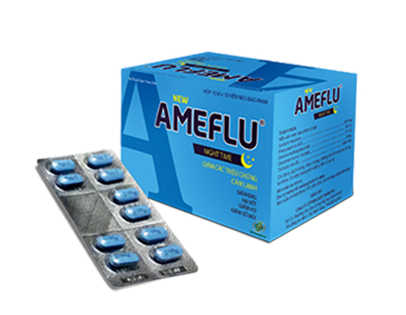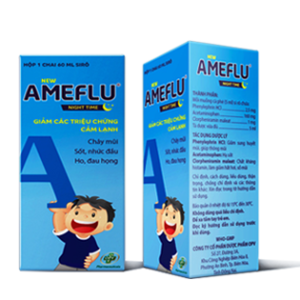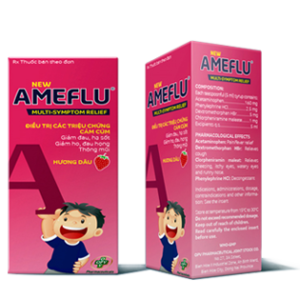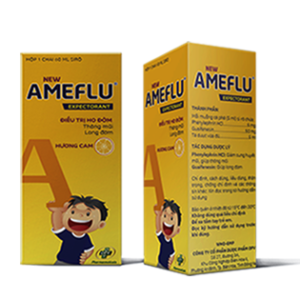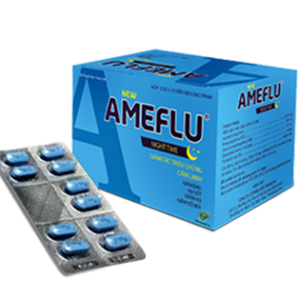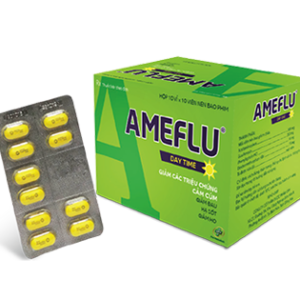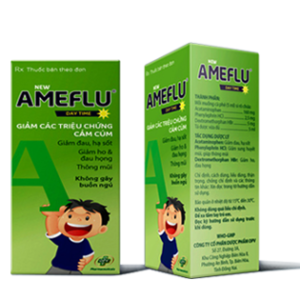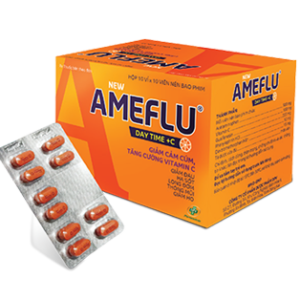1. COMPOSITION:
Each film coated tablet contains:
Active ingredients:
Paracetamol….……………….500 mg
Cafein…………………..…………25 mg
Phenylephrin HCl………………5 mg
Excipients: Pregelatinized starch, lactose monohydrate, colloidal anhydrous silica, sodium starch glycolate, maize starch, povidone K30, talc, magnesium stearate, opadry II white, quinoleine yellow lake.
2. DESCRIPTION OF PRODUCT:
Yellow, oblong shaped, film-coated tablet, printed “AMEFLU” on one side. The tablet is intact.
3. DESCRIPTION OF PACKAGING:
Box of 10 blisters x 10 film coated tablets.
4. WHAT IS THE MEDICINE USED FOR:
Relieving the symptoms of colds and flu, such as headache, sore throat, aches and pains, nasal congestion, sinus pain associated with sinusitis, fever.
5. HOW MUCH AND HOW OFTEN SHOULD YOU USE THIS MEDICINE:
Administration: Oral.
Dosage:
Adults and children over 12 years of age: 1-2 tablets, 4 times a day.
- Do not take more than 8 tablets in a 24 hour period.
- Do not take this medication with any other products containing paracetamol.
- Do not take continuously for more than 7 days without medical advice.
- The dose should not be repeated more frequently than every four hours.
Children under 12 years of age: Not recommended.
6. WHEN SHOULD YOU NOT TAKE THIS MEDICINE:
Do not take AMEFLU if:
- You have ever had an allergic reaction to paracetamol, phenylephrine hydrochloride, caffeine or any of the other ingredients of this product.
- Children under 12 years of age.
- You have severe coronary artery disease, severe hypertension, cardiovascular disease, hyperthyroidism and you who are taking or have taken, within the last two weeks, monoamine oxidase inhibitors.
- You are taking sympathomimetic decongestants.
- You have pheochromocytoma.
- You have closed angle glaucoma.
- You have hepatic or severe renal impairment.
- You are taking tricyclic antidepressants, or beta-blocking drugs within the last two weeks.
7. SIDE EFFECTS:
Stop taking this medicine and tell your doctor immediately if you have one of the following rare side effects:
- Allergic reactions which may be severe such as skin rash and itching sometimes with swelling of the mouth or face or shortness of breath.
- Skin rash or peeling, or mouth ulcers.
- Breathing problems. These are more likely if you have experienced them before when taking other painkillers such as ibuprofen or aspirin.
- Unexplained bruising or bleeding.
- Reoccuring fevers or infections.
- Nausea, sudden weight loss, loss of appetite and yellowing of the eyes and skin.
- Visual disturbances. This is rare but is more likely in those with glaucoma.
- Unusually fast pulse rate or a sensation of an unusually fast or irregular heartbeat.
- Difficulty passing water. This is more likely to occur in men with an enlarged prostate gland.
Other side effects of this medicine are:
- Raised blood pressure, headache, dizziness, difficulty sleeping, nervousness, anxiety, diarrhea, or sickness.
In case of any unexpected reactions, consult your doctor or pharmacist.
8. WHAT OTHER MEDICINE OR FOOD SHOULD BE AVOIDED WHILST TAKING THIS MEDICINE:
Talk to your doctor before taking AMEFLU if you are taking one of the following medicines:
- Metoclopramide or domperidone (for nausea or vomiting).
- Ergotamine and methlysergide (for migraine).
- Colestyramine (to lower blood cholesterol).
- Drugs to lower blood pressure.
- Appetite suppressants or stimulants.
- Drugs to treat depression such as tricyclic antidepressants (such as amitriptyline).
- Drugs for heart diseases (such as digoxin).
- Blood thinning drugs (such as warfarin).
- Barbiturates.
- Clozapine.
9. WHAT SHOULD YOU DO IF YOU MISS A DOSE:
If you miss a dose, take it as soon as you remember. If it is near the time of the next dose, skip the missed dose and resume your usual dosing schedule. Do not double the dose to catch up.
10. HOW SHOULD YOU KEEP THIS MEDICINE:
Store at temperature below 30oC, in a dry place, protect from light.
11. SIGNS AND SYMPTOMS OF OVERDOSE:
Paracetamol
Symptoms
Symptoms of paracetamol overdose in the first 24 hours are pallor, nausea, vomiting, anorexia and abdominal pain. Liver damage may become apparent 12 to 48 hours after ingestion. Abnormalities of glucose metabolism and metabolic acidosis may occur. In severe poisoning, hepatic failure may progress to encephalopathy, haemorrhage, hypoglycaemia, cerebral oedema and death. Acute renal failure with acute tubular necrosis, strongly suggested by loin pain, haematuria and proteinuria, may develop even in the absence of severe liver damage. Cardiac arrhythmias and pancreatitis have been reported.
Caffeine
Symptoms
Overdose of caffeine may result in epigastric pain, vomiting, diurese, tachycardia or cardiac arrhythmia, CNS stimulation (insomnia, restlessness, excitement, agitation, jitteriness, tremors and convulsions).
It must be noted that for clinically significant symptoms of caffeine overdose to occur with this product, the amount ingested would be associated with serious paracetamol-related liver toxicity.
Phenylephrine:
Symptoms
Phenylephrine overdosage is likely to result in effects similar to those listed under adverse reactions. Additional symptoms may include hypertension, and possibly reflex bradycardia. In severe cases confusion, hallucinations, seizures and arrhythmias may occur. However the amount required to produce serious phenylephrine toxicity would be greater than that required to cause paracetamol-related liver toxicity.
12. WHAT TO DO WHEN YOU HAVE TAKEN MORE THAN THE RECOMMENDED DOSAGE:
Talk to your doctor or go to a hospital straight away.
Remember to take medicine that is left with you or medicine pack so the doctor knows what you have taken.
13. PRECAUTIONS THAT SHOULD BE TAKEN WHEN TAKING THIS MEDICINE:
– Can cause rare but serious skin reactions, can cause death including Stevens-Johnson Syndrome (SJS), toxic epidermal necrolysis (TEN), or Lyell Syndrome, acute generalized exanthematous pustulosis (AGEP).
– Description of above syndromes:
+ Steven-Johnson syndrome (SJS): drug allergies can be bullous, bullae localize around the natural cavities: the face, nose, mouth, ears, genitals and anus. Also may include high fever, pneumonia, liver, kidney dysfunction. Diagnosis of Steven-Johnson syndrome (SJS) when at least two natural cavities injured.
+ Toxic epidermal necrolysis (TEN) is the most severe allergic reactions can include:
– The diversity in skin lesions: morbilliform erythema, scarlatinoid erythema, erythema or bullous erythema, the lesions rapidly spread throughout the body;
– Ophthalmic mucosa lesions: corneal inflammation, purulent conjunctivitis, corneal ulcer.
– Injury to gastrointestinal mucosa: stomatitis, erosive oral mucosa, ulceration of pharynx, throat, esophagus, stomach, intestines;
– Injury to the genital, urinary mucosa.
– There are also the serious systemic symptoms such as fever, gastrointestinal bleeding, pneumonia, glomerulonephritis, hepatitis,… high mortality rate: 15-30%.
+ Acute generalized exanthematous pustulosis (AGEP): small, sterile pustules, arising within large areas of erythema. Lesions usually appear in the folds like the underarms, groin and face, then can spread throughout the body. Usual systemic symptoms of fever, neutrophilia in blood test.
– When detecting first signs of skin rash or any other hypersensitivity reaction, patients should stop using the drug. Patients with history of severe skin reaction caused by paracetamol, do not take again, inform the medical staff when having medical care.
Consult a doctor before taking AMEFLU if you:
– have an enlarged prostate.
– have a blood vessel disease such as Raynaud’s phenomenon.
– have heart or circulation disease.
– have diabetes.
– have a history of peptic ulcer.
– are taking beta-adrenergic blockers.
Excessive intake of caffeine (e.g. coffee, tea and some canned drinks) should be avoided while taking this product.
Do not take more than the recommended dose of AMEFLU.
Do not take other products containing paracetamol when taking AMEFLU.
If symptoms persists, consult your doctor.
Keep out of the reach and sight of children.
Consult your doctor if you are taking warfarin.
Immediate medical advice should be sought in the event of an overdose, even if you feel well, because of the risks of delayed, serious liver damage.
This drug contains lactose. Patients with rare hereditary problems of galactose intolerance, Lapp lactose deficiency or glucose-galactose malabsorption should not take this medicine.
Pregnancy and lactation:
Due to the caffeine content of this product it should not be used if you are pregnant or breast feeding.
Effects on ability to work:
This product may cause dizziness. If affected do not drive, operate machinery, work at height or other activities.
14. WHEN SHOULD YOU CONSULT YOUR DOCTOR OR PHARMACIST:
- In case of overdosage or adverse drug reactions.
- When you are taking other drugs or foods.
For further information, consult your doctor or pharmacist.
15. SHELF-LIFE OF DRUG:
36 months from manufacturing date. Do not use after expiry date.


